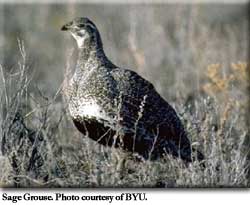|
 The Mitigation
Commission is supporting conservation and recovery of sage grouse in
Utah's Strawberry Valley. The Strawberry
Valley Area Assessment, which was developed by the Mitigation
Commission and Heber Ranger District of the Uinta National Forest, found
the species to be operating outside of a properly functioning condition
and at risk. The Mitigation
Commission is supporting conservation and recovery of sage grouse in
Utah's Strawberry Valley. The Strawberry
Valley Area Assessment, which was developed by the Mitigation
Commission and Heber Ranger District of the Uinta National Forest, found
the species to be operating outside of a properly functioning condition
and at risk.
Based on this assessment and because enlargement
of Strawberry Reservoir, as part of the Central Utah Project, inundated
four out of five historic sage grouse leks (displaying and breeding
areas), the Commission is funding sage grouse research and monitoring. Study participants include Brigham Young University, U.S. Forest
Service, Utah Division of Wildlife Resources, and U.S. Fish and Wildlife
Service. Information gained is being used to develop a sage grouse recovery
strategy.
To aid recovery efforts, the Commission acquired a large block of high value upland habitats used by sage grouse and other wildlife in 2006. The 1,720-acre parcel connects two CUP mitigation areas: the Wildcat Canyon Wildlife Management Area and the Strawberry River Wildlife Management Area. In 2009, about 2,600 acres of critical big game and sage grouse habitat were acquired.
In addition, about 175 birds have been translocated to the affected area to date. Survival of translocated hens and their flocking with resident sage grouse indicate translocation has been successful. The count of birds on the lek supports the notion that recovery is beginning to occur. In 2006, a 200% increase in lek attendance over 2005 was noted, and the third highest lek count ever was recorded on the Road Hollow lek. Population numbers are still below levels considered necessary for long-term sustainability, but progress is being made.
|